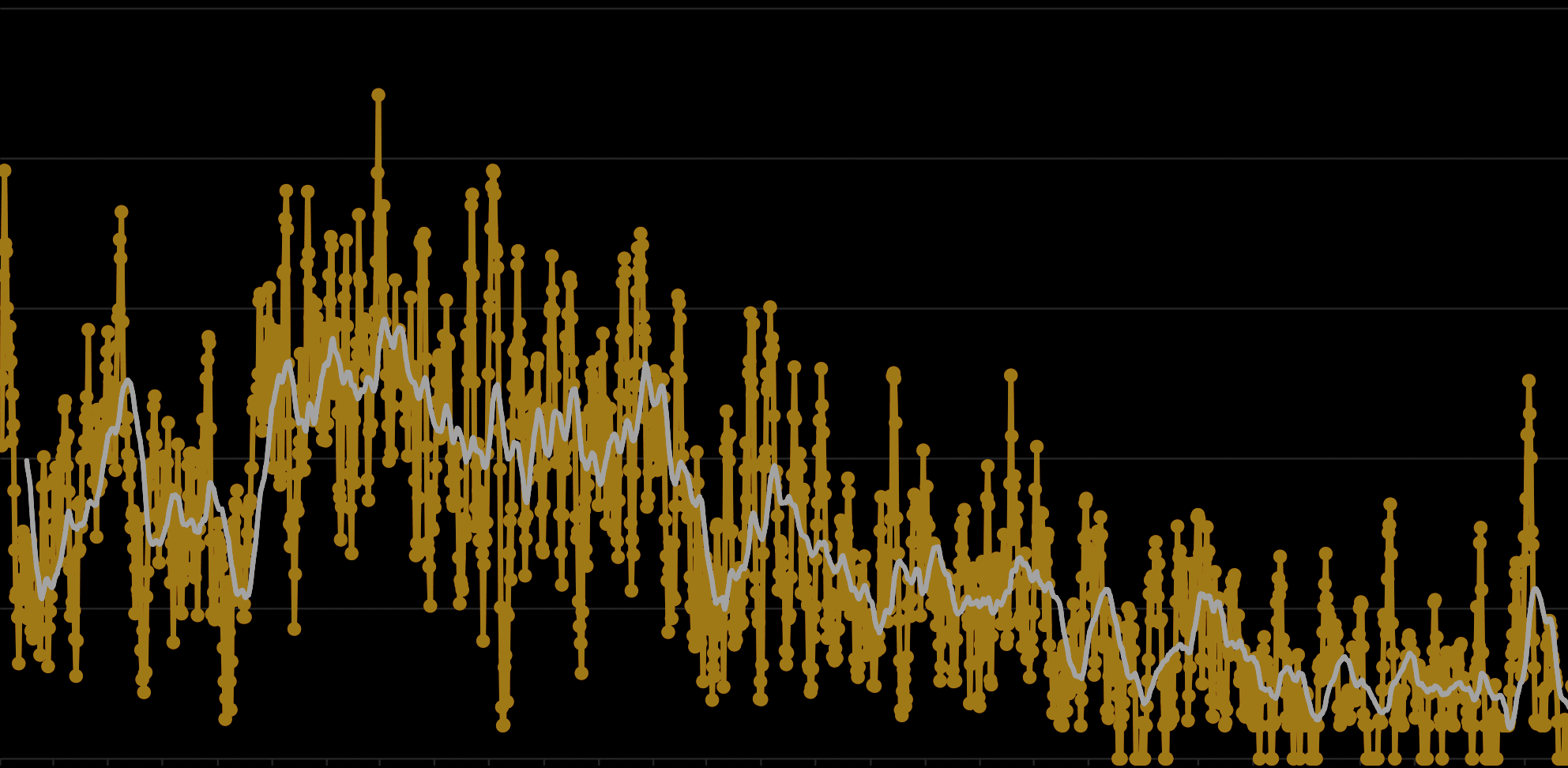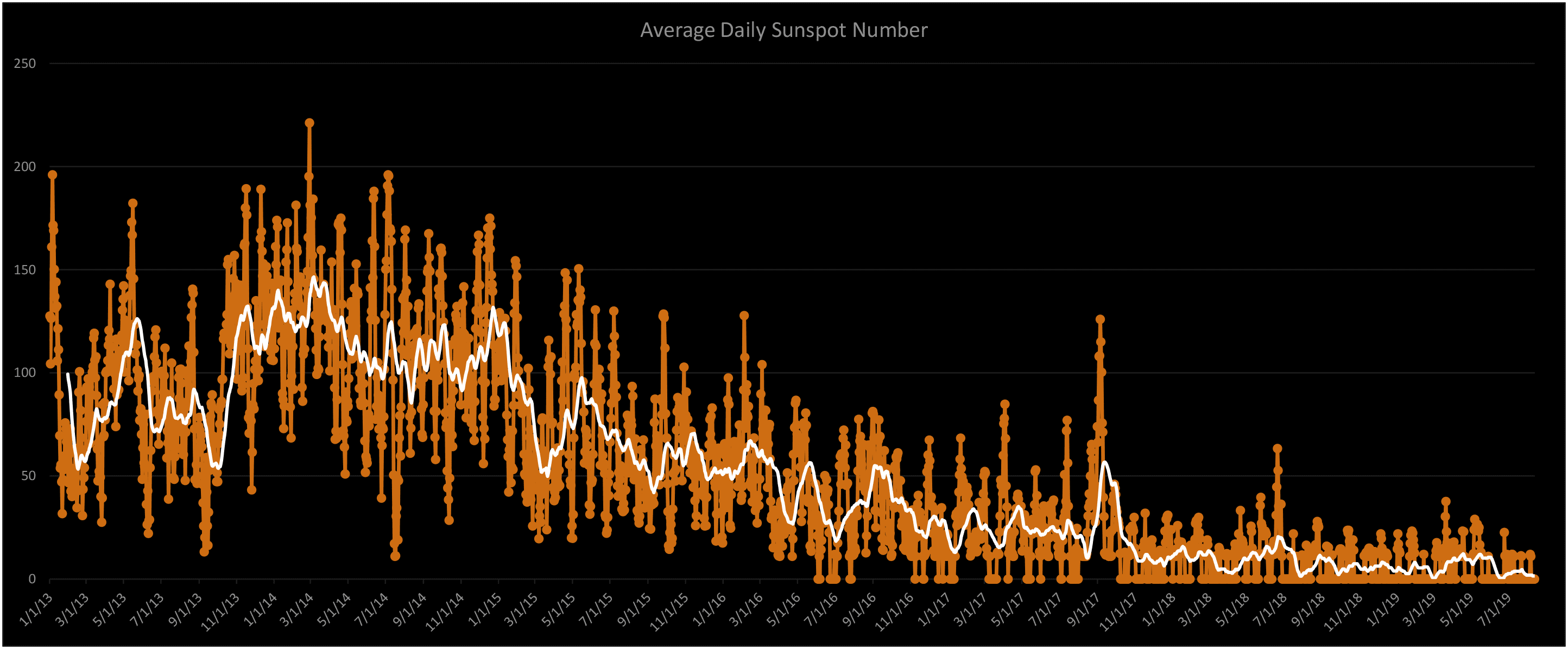
Solar Variability: Our Inconstant Sun
September 2019 :
I went to bed last night wondering where the Sun had gone. Then it dawned on me. A little astronomy humor to begin a serious discussion on our life-giving star—the Sun.
Our Sun coalesced out of a vast cloud of gas and dust some 100 times the size of our solar system roughly five billion years ago. Gravity contracted this mass until the core of this proto-star reached about 24.5 million degrees Fahrenheit. At that time nuclear fusion began, converting about 600 million tons of hydrogen to helium per second. This process has been ongoing since then.
Most folks take for granted that the Sun rises and sets every day due to the Earth’s almost 24-hour rotation. The only change most people recognize is the seasonal cycles caused by the fixed 23.5 degree tilt of our planet’s axis in its orbital path about the Sun. Reference this video to refresh your memory on the Earth’s annual journey: https://www.youtube.com/watch?v=d6rgyJkrMXg
Although our Sun is a very stable G2 yellow dwarf star, it does have a slight “variability.” Over an average 11-year cycle solar activity waxes and wanes. Most apparent of this activity manifests itself in the appearance of dark sunspots, regions of intense magnetism residing as depressions in the Sun’s photosphere (the visible “surface” of the Sun). Solar activity rises from solar minimum, where no or few sunspots are visible, to solar maximum, where hundreds of sunspots can be counted. That peak activity then subsides back down to another solar minimum. This period is called a solar cycle, and currently we are at solar minimum at the end of Cycle 24, which began in January 2008. (All other solar activity follows this pattern, including solar flares, prominences and coronal mass ejections (CME’s).
There is also a 22-year cycle. At the end of an 11-year cycle, groups of the new cycle have reversed polarity magnetic fields. You can read more about this topic and other pertinent solar facts on the Skyscrapers website: http://www.theskyscrapers.org/stuff/contentmgr/files/2/f19a9ea97f57f5a6effa42c91b8dc910/documents/solar_lab.doc. The appearance of reversed polarity groups, along with the fact that they form at higher north and south solar latitudes, indicates the Sun is transitioning to a new cycle. However, groups of old and new polarities do coincide during the transition.
Current Cycle 24 was slightly unusual in that it sported two peaks. The largest, in April 2014, was preceded by an earlier peak in March 2012. Despite this scenario, Cycle 24 displayed the lowest peak since 1906.
Also, the last minimum, between Cycle 23 and Cycle 24, was quite deep (prolonged). There were many spotless days. At the time I was searching the solar literature online looking to see if solar physicists were thinking of giving that period a name. Other deep minimums which produced global climate effects received names like the Maunder Minimum (1645-1715), Dalton Minimum (1790-1830) or Sporer Minimum (1450-1540). Fortunately, a group of the new cycle formed and Cycle 24 began.
Original forecasts of very high solar activity for Cycle 24 were predicted. However, as the months progressed the forecasts were downgraded.
It is an easy task to follow the progress of each solar cycle. Decades ago, I used my own telescope equipped with a special solar filter to conduct sunspot counts. This process was fine for clear or partly cloudy days, but often around here in southern New England we can experience days upon days of overcast skies. Today, solar observatories orbiting the Earth provide uninterrupted high-resolution solar images, thereby making sunspot counting very convenient.
Several members of Skyscrapers have been participating in a sunspot count project since September 18, 2012. In addition, in order to provide my Bryant University astronomy lab students an “eyes on” project, they conduct sunspot counts for an 11-week period each semester. During solar maximum it was indeed a challenge for them to get the hang of determining groups and counting spots. However, by the end of a semester most of them became good solar observers. I wish they could have continued once the lab finished.
As Cycle 24 continues towards solar minimum (a determination of which can be made only after we have reached and surpassed it), there have been many spotless days. 2018 totaled 221 days, while 2019 up through July 20 has totaled 130 days with no spots. Not necessarily consecutive days. Short-lived groups with less than five spots each were the norm if they evolved. Despite the apparent low numbers, solar physicist Lisa Upton with Space Systems Research Corp believes there is “no indication that we are currently approaching a Maunder-type minimum in solar activity.”

That is good news. Humankind would find a deep minimum very disruptive. Reference this website https://en.wikipedia.org/wiki/Maunder_Minimum on the Maunder minimum to increase your awareness of the consequences. Even now cosmic rays pose an intensified threat to astronauts and passengers in high flying aircraft due to a decreased solar magnetic field. The lack of solar activity also allows the Earth’s atmosphere to shrink, preventing space debris from de-orbiting due to atmospheric drag.
The opposite extreme also poses danger. When solar activity is high, our atmosphere expands, thereby increasing drag on our orbiting spacecraft. In fact, Skylab, a United States orbital laboratory, reentered the Earth’s atmosphere ahead of schedule in July 1979 due to this specific problem. Most of it plummeted into the Indian Ocean, while some pieces fell in Western Australia.) And on March 11, 1989, Hydro-Quebec was shutdown by a huge geomagnetic storm caused by an intense solar storm. Circuit breakers tripped when transformers melted due to the amount of energy that entered the system from the event.
According to solar physicist Lisa Upton, “We expect Solar Cycle 25 will be very similar to Cycle 24: another fairly weak maximum, preceded by a long, deep minimum.” The current solar minimum will continue thru 2019, likely ending in 2020. The next solar maximum is expected in 2024-2026.
Unfortunately, the relatively small variability in solar activity has far reaching consequences for climate change. I have read reports hoping for a Maunder-type minimum in the hopes a decades-long solar minimum would mitigate the effects of global warming. Yes, global warming. Precisely stated. Climate change says little. I’ve become quite cynical as I’ve aged, and I believe humankind is past the point of intervention. I’m unsure whether a natural phenomenon could bring about a recovery either. Agricultural and socio-economic interests will be adversely compromised whichever way it goes.
In 1789 Benjamin Franklin stated, “Our new Constitution is now established, and has an appearance that promises permanency; but in this world nothing can be said to be certain, except death and taxes.” While the permanency of the Sun is guaranteed for another five billion years, let’s hope extreme solar variability does not threaten our already fragile ecology.
The collected data shown here from January 1, 2013 through August 12, 2019. Graph shows the average relative sunspot number for every day for all observers. The relative sunspot number is calculated using this formula: R=10(number of groups) + number of spots. So, if I counted 4 groups and 20 spots on a given day my relative number would be 10(4) + 20 + 60. The graph shows the daily changes in sunspot activity.
Current Cycle 24 was slightly unusual in that it sported two peaks. The largest, in April 2014, was preceded by an earlier peak in March 2012.
Despite this scenario, Cycle 24 displayed the lowest peak since 1906. In July a reversed polarity spot group suggests the next cycle, #25, has begun. Having made that assertion, solar cycles do overlap. The Sun continues in solar minimum. The following data for spotless days as reported by Spaceweather.com: 2019 thru Aug 12 - 149 or 67%; 2018 = 221, or 61%; 2017 = 104, or 28%; 2016 = 32, or 9%.



